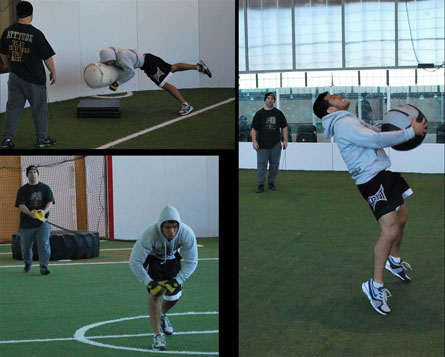Four Basic Types of Strength & Conditioning Exercises.
There are four basic kinds of exercises in every strength & conditioning program which I prescribe. These four kinds of exercises build the foundation which you need as an athlete or even just day to day to perform your daily activites.

Picture of Phillipe Nover in training.
1. Prehabilitation/Rehabilitation Exercises
What are they?
They can be your warm-up drills, mobility drills, flexibility movements and sport-specific drills.
Why do them?
- They help increase your range of motion and allows for better movement during your training.
- They also help prevent injury as most of such movements strengthen up our stability in our joints.
- More sport-specific drills can be added to help increase coordination and conditioning of the muscles specfic to the sport.
When to do them?
- Prehab/Rehab work can be done at the start of your program. This is when you are not fatigued from the workout and can concentrate on targeting the correct muscles in the movements.
- Additional stretching and flexibility work can be added to the end of the workout to further increase range of motion and facilitate recovery.
2. Power-Based Exercises
What are they?
Movements that require you to be explosive and develop as much force as possible in the shortest period of time. They include your jumps, throws, and Olympic-weightlifitng movements.
Why do them?
- They allow you to increase your rate of force development which is critical and most of the time a key performance indicator in more sport settings.
- Some of the movements involved are more complex and require coordination of the body (e.g. the Snatch/Clean+Jerk).
- They build your muscles up to move faster, allowing you to have better movement speed (e.g. being able to move your leg fast enough to catch yourself when you fall).
- Better activation of the core as such movements are dynamic and require your spine to be in a stabilised position constantly while the movement is performed.
- And because you are developing high force in fast speeds, you are doing more work more rapidly, increasing your energy-expenditure and subsequently allowing weight loss.
When to do them?
- Similar to Prehab/Rehab movements, they require concentration and coordination so they should be done early in the program if possible.
- They can be placed immediately after a strength-based exercise to allow for potentation in the muscles (which simply means that the strength exercise will give a boost to your muscles and warm them up to perform an explosive movement).
3. Strength-Based Exercises
What are they?
Usually the Three Big Lifts (i.e. The Squat, The Deadlift and The Bench) and their assistance exercises.
Why do them?
- They allow your muscles to develop as much force as possible through a range of motion, giving you the foundation required for your training.
- They also help increase muscle mass and with more muscles mass, energy expenditure is increased, allowing for weight loss.
- The strength built can later be transferred to power which is critical in alot of movements we perform daily and in sport.
When to do them?
- This will take up the bulk of the program as you can target various bodyparts and muscle groups.
- They can be done after prehab/rehab work at the beginning of the program.
- A low level of coordination is required so they can also be performed after power-based exercises.
- The main goal of strength-based exercises is to increase the strength in your muscles and the ability to produce as much force as you can. That's why they make up the bulk of your program.
4. Core Exercises
What are they?
Any movement which requires your core to be in a stabilised position. The misconception that many have about core training is that the core needs to be worked with crunches/sit-ups which is seldom the case.
Why do them?
- The core (as the name suggests) provides the stability in all our movements.
- Force and power is never generated from the core but by the limb segments and is magnified if the core is stable.
- For example, throwing a ball requires moving your arm through a certain range. However, the first muscles to be activated are in fact your core muscles to give you that stability and allow you to transfer the force from your hips to your shoulders then to your arms.
When to do them?
- Core training is traditionally done at the end of the program as you would want to "save your energy" for your major exercises and core training is seen as an accessory form of training.
- Moreover, your core would already be at use when you perform the Big Lifts which require alot of stabilisation in the trunk to allow for safe lifting.
- Another recent discovery is that core training can be performed before your major movements to allow for the core to be pre-activated and facilitate stability when performing the major lifts after.
- However, it's a fine line getting the right amount of core work done for pre-activation and not tiring it out so much that it affects your major lifts. So my suggestion is to perform just one exercise engaging your core if you intend to do core work before major lifting.
So that's basically the four kinds of exercises you should be having in every strength and conditioning program. If someone gives you a program and does not have at least two or three of those components, you should start having your doubts in them. Hope that helps with your programming and allows you to achieve your training goals!
Stay Strong and Keep Moving,
The Training Geek.
